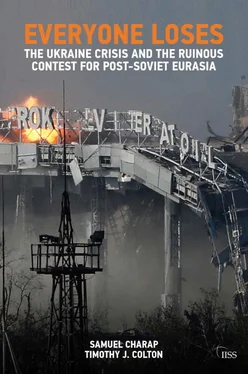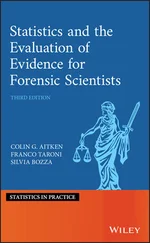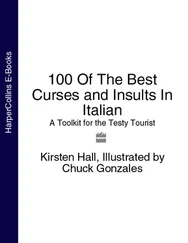Other explanations have turned the lens from the international level to the domestic. The events of 2014, accordingly, are said to have flowed from changes inside the perpetrator, Russia, and the Kremlin’s response to them. As Michael McFaul and Kathryn Stoner-Weiss write, ‘Russia’s foreign policy, including specifically the annexation of Crimea and military intervention in Eastern Ukraine, did not change in response to [Western policy]. Rather, Russian foreign policy changed in large measure as a result of Putin’s response to new domestic political and economic challenges inside Russia.’ [10] Kathryn Stoner and Michael McFaul, ‘Who Lost Russia (This Time)? Vladimir Putin’, Washington Quarterly , vol. 38, no. 2, Summer 2015, p. 175.
Specifically, Putin’s approval ratings slackened following the flawed 2011–12 election cycle, there were street protests in Russian cities in that period, and economic growth slowed, casting doubt on the previous social contract. The Kremlin decided to fashion a new contract based on protecting the Russian people from external threats. ‘To maintain his argument for legitimacy at home, Putin needs perpetual conflict with external enemies.’ [11] Ibid. , p. 181.
To be sure, the Ukraine crisis provided a domestic political windfall for Putin; his approval ratings hit stratospheric highs after the annexation of Crimea, peaking at nearly 90%. But we should be wary of confusing cause and effect. By the time Yanukovych’s government fell, Putin had effectively addressed the challenges of 2011–12. He had squelched organised opposition through targeted repression; opened new release valves for discontent through measures like a return to gubernatorial elections; and reinforced the loyalty of his coterie through a drive for ‘nationalisation of the elite’. In other words, as the Maidan Revolution unfolded in Ukraine, Putin faced no serious threat to his rule in the short to medium term, enjoying prodigious popular support and elite fealty. It seems far-fetched that under these circumstances he would have taken so disruptive and risky a set of actions purely in order to prop himself up politically at home.
Rajan Menon and Eugene Rumer, in Conflict in Ukraine: The Unwinding of the Post-Cold War Order , rightly point our attention to the regional context. They argue that ‘what has happened is a symptom of a much larger and more complicated problem’, namely that ‘the entire post-Cold War European political and security architecture was built on the foundation of two institutions – the European Union and NATO – which did not include Russia’. [12] Rajan Menon and Eugene Rumer, Conflict in Ukraine: The Unwinding of the Post-Cold War Order (Cambridge, MA: MIT Press, 2015), pp. xix, 162.
The West, they note, gambled that Russia would accept these institutions, which proved to be a bad wager. Instead, more thought should have been given to a new post-Cold War regional order that Russia could have joined.
This argument is a worthy one to consider, and we explore it below. The decisions made between German reunification in 1989 and the decision to enlarge the EU and NATO in 1993 and 1994 led, largely inadvertently, to a regional order in Europe that could not feasibly incorporate Russia. Yet this shortcoming cannot fully account for the current conflict between Russia and the West. For quite a few years, Russia had an often unhappy but nonetheless functional relationship with the Euro-Atlantic institutions. It could have persisted if there had not been a test of wills in post-Soviet Eurasia. Clearly, the possibility that NATO and the EU might eventually assimilate, in some way, all of Russia’s neighbours, but not Russia itself, was a worry for the Kremlin, and one determinant of its intemperate reaction to the Maidan Revolution. But the decision to extend those institutions’ outreach into post-Soviet Eurasia was made over the course of a decade after the mid-1990s, as one element of a broader contest for influence in the region. It is this contest that grew into a negative-sum interaction, and this contest that will be the focus of our book.
While the lack of an inclusive post-Cold War architecture was a precondition for the Ukraine crisis, this ruinous outcome could have been averted without revisiting the fundamentals of the European order. It was the contestation over the lands between Russia and the West that led to the explosion in Ukraine and sent tensions spiralling out of control.
We begin the next chapter with an examination of the foundational years of the post-Cold War order (from the late 1980s to the mid-1990s), since decisions taken in that period foreclosed the opportunity to erase completely the continent’s dividing lines. Had that opportunity been seized, it could have headed off the Ukraine crisis and the broader regional contestation that long antedates it. Our book elides those disputes between Russia and the West since 1991 that did not bear directly on this negative-sum game – such as divergences over Russia’s wars in Chechnya, ballistic-missile defence, the US occupation of Iraq, the civil war in Syria and the Western military intervention in Libya, to name just a few. This is not just a matter of establishing a clear scope. All these episodes did, to varying degrees, harm relations between Russia and the West. But the damage was limited and manageable. By contrast, the tensions resulting from the regional contestation that culminated in the Ukraine crisis were neither limited nor manageable. An understanding of the origins of the crisis is thus central to explaining how we got to this low ebb in Russia–West ties and how we might get out of it.
A brief word about geographic references: Historians, politicians and opinion-makers argue endlessly about the appropriate descriptors for countries and regions on the world map. For the lands that populate this book, there are a host of disputed terms: Eastern Europe, East Central Europe, Central Europe, Russia and Eurasia are prominent among them. Settling these terminological debates is beyond our remit here. We will avoid the phrases Eastern Europe and Central Europe, although we will quote them verbatim if characters in our story utter them. We will use East Central Europe to refer to the states that were part of the Soviet-dominated Warsaw Pact during the Cold War and are now members of NATO and the EU, and thus of the West. Russia will be used to refer to the post-Soviet state that under its constitution bears the dual moniker Russia and the Russian Federation. Eurasia is the most loosely defined of these terms, describing a space that spans the continental divide between Europe and Asia. We will apply the label post-Soviet Eurasia to the area occupied by the successor states to the Soviet Union. For a few years after 1991, post-Soviet Eurasia may be said to have covered the three Baltic countries (Estonia, Latvia and Lithuania), but they speedily exited the category and will be treated in the bulk of what follows as part of East Central Europe.
Where to find the roots of the disastrous scene at the Donetsk airport? One might well look to background factors such as Russian imperialism, ancestral enmities over language and religion, Soviet nationality practices, and the micro-history of Crimea and the Donbas. Although variables like these are germane at some level of abstraction, our emphasis is on dynamics in the relative foreground.
The Ukraine crisis, as we see it, comes out of self-reinforcing adversarial behaviour in the post-Soviet section of the Eurasian macroregion. Stretching over a quarter-century but gathering momentum in the second half of that time span, this contest has given rise to a belt of instability, insecurity and discontent of which Ukraine is but one part. The multidimensional rivalries percolating there encapsulate three ‘geos’ pursued by states and blocs of states: geopolitics, which is standard-issue realpolitik with special attention to attaining influence over particular countries or areas; geo-economics, or the projection of power over territory using economic means, an exercise defined by ‘the logic of war in the grammar of commerce’; [1] Phrase taken from the foundational argument about geo-economics in Edward N. Luttwak, ‘From Geopolitics to Geo-Economics: Logic of Conflict, Grammar of Commerce’, National Interest , no. 20, Summer 1990, pp. 17–23.
and geo-ideas, by which we mean policies to spread normative conceptions of the good and the right beyond national borders. [2] Lest this triad sound overly rationalistic, we concede that non-rational variables – such as arrogance, bureaucratic red tape, carelessness and sloth – also entered into the picture we describe. We are grateful to Neil MacFarlane for drawing our attention to this point. Our take, though, is that these factors were at work on all sides and did not tip the outcome in any one direction.
Читать дальше











